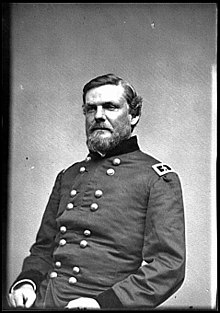John Newton (engineer)
| John Newton | |
|---|---|

John Newton
|
|
| Born |
August 24, 1823 Norfolk, Virginia |
| Died | May 1, 1895 (aged 71) New York City, New York |
| Place of burial | West Point National Cemetery |
| Allegiance |
United States of America Union |
| Service/branch |
United States Army Union Army |
| Years of service | 1842–1886 |
| Rank |
|
| Commands held | |
| Battles/wars | |
| Other work |
|
John Newton (August 24, 1823 – May 1, 1895) was a career engineer officer in the United States Army, a Union general in the American Civil War, and Chief of the Corps of Engineers.
Newton was born in Norfolk, Virginia, a city his father Thomas Newton, Jr. represented in the U.S. Congress for 31 years. He ranked second in the United States Military Academy class of 1842 and was commissioned in the Corps of Engineers. He taught engineering at the Military Academy (1843–46) and constructed fortifications along the Atlantic coast and Great Lakes (1846–52). He was a member of a special Gulf Coast defense board (1856) and Chief Engineer, Utah Expedition (1858).
Though a fellow Virginian, Newton did not follow Robert E. Lee but stood firm for the Union. Newton helped construct Washington defenses and led a brigade in the Peninsula Campaign. In the Maryland Campaign, at South Mountain, he led a bayonet charge that resulted in taking the enemy position, and also fought at the Battle of Antietam.
As a division commander in the VI Corps, he participated in the Battle of Fredericksburg. After that disastrous defeat, he and other generals journeyed to see President Abraham Lincoln and informed him of their lack of confidence in Army of the Potomac commander, Maj. Gen. Ambrose E. Burnside. This was one of the causes of Burnside's relief in January 1863, but it also wounded Newton's career; his appointment to major general on March 30, 1863, was withdrawn the following year when his involvement was understood.
...
Wikipedia
